
Cover art by Frank Frazetta
Night Walk is a science fiction novel by Bob Shaw, first published in 1967.

Night Walk is a science fiction novel by Bob Shaw, first published in 1967.
Emm Luther is a planet ruled by a single, worldwide theocracy. It is evenly populated, and a couple of railroads run up and down the coasts of the largest continent. Earth sends secret agent Sam Tallon to Emm Luther to infiltrate the theocracy and extract the coordinates of the "null-space" (hyperspace) jump points of a newly discovered colonizable world, a closely guarded secret.
When the religious secret police discover that he has false credentials and has entered their world under false pretenses, a frantic chase and flight ensues. He is captured in his hotel room. A high-ranking officer named Cherkassky tries to render Tallon harmless by erasing his memory of the jump data, using a device called a "brain brush". He thinks that he has succeeded, but Tallon is equipped with a gadget that can sequester certain memories. Cherkassky enjoys tormenting people, and he is known for destroying most of the memories of prisoners who annoy him. He begins by erasing Tallon's memory of a loved one; the sense of loss enrages Tallon, and he attacks Cherkassky in a bid for escape. He is blinded when Cherkassky shoots him in the face with a dart gun, destroying his eyes. He is taken to a secret prison complex in the southernmost tip of the most distant continent to convalesce. While he is there, he enlists the aid of the scientific elite among the other political prisoners there, and together they design a pair of electronic "sonar" eyes. The headgear delivers different tones to distinguish various objects. Later, they make another breakthrough: they make a device that can sense and interpret the nerve signals of the eyes of nearby living things. Tallon can now see, but only through others' eyes. After they develop and test this device, Tallon and his partner Winfield try to break out, but Winfield is shot during the attempt. Tallon must flee alone, depending on encountering local animal life in order to see.
Tallon escapes and travels across the continent, reaching his secret contact after much difficulty, and with the help of his love interest Helen Juste. When he has a chance to escape the planet, though, he is delayed by trying to bring his lover with him. Later, when he does try to depart, he finds that his ship is filled with police. Battle ensues, and he seems to be the sole survivor. He boards the ship and starts a null-space jump to a random point in the universe. Now blind since there isn't anyone in the ship, he must somehow master the intricacies of the "jump stick," a form of jump drive via portals to null-space (a hyperspace parallel universe, through which FTL space travel is achieved). However, further trouble arrives in the form of Cherkassky, who also survived the battle for the ship. They fight, and Cherkassky is killed. Tallon finds a mouse to function as his eyes. He solves the mathematical problems concerning null-space travel by discovering that he can also see through the eyes of people in other ships traversing various routes through null-space. He gains knowledge of the structure of null-space (a Kummer surface) that space travelers will find invaluable. He eventually reaches home with his enemy (and some loved ones) dead, but his new knowledge helps bring about greater peace.

Mostly Harmless is a 1992 novel by Douglas Adams and the fifth book in the Hitchhiker's Guide to the Galaxy series. It is described on the cover of the first edition as "The fifth book in the increasingly inaccurately named Hitchhikers Trilogy". It was the last Hitchhiker's book written by Adams and his final book released in his lifetime.
Escape Velocity Nova is a video game developed by Ambrosia Software in collaboration with ATMOS. It is the third game in the Escape Velocity series of space trading and combat games. It was released on March 19, 2002 for Mac OS X and Mac OS 9, and later ported to Windows and released on July 11, 2003. The game's premise, set in a time period after mankind has discovered hyperspace technology, grants the player freedom to take missions, trade goods, steal from other ships, and enter one of six storylines.
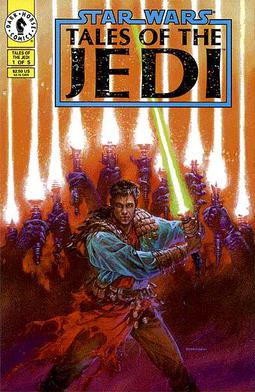
Star Wars: Tales of the Jedi is a series of comic books published by Dark Horse Comics between 1993 and 1998. They are part of the fictional Star Wars expanded universe, and cover the Great Sith War and the Great Hyperspace War. The series represented the earliest chronological Star Wars stories until the publication of the Dawn of the Jedi series of comics and novels.

The Chanur novels are a series of five science fiction novels, forming three separate stories, written by American author C. J. Cherryh and published by DAW Books between 1981 and 1992. The first novel in the series is The Pride of Chanur (1981), which was nominated for both the Hugo and Locus Awards in 1983. The Pride of Chanur, originally a stand-alone story, was followed by the Chanur's Venture trilogy, Chanur's Venture (1984), which was shortlisted for a Locus Award in 1985; The Kif Strike Back (1985) and Chanur's Homecoming (1986). These were followed by a later sequel, Chanur's Legacy (1992). The five novels were also published in two omnibus editions: the first three in The Chanur Saga in 2000 and the next two in Chanur's Endgame in 2007.
"The Search" is the 47th and 48th episode of the science fiction television show Star Trek: Deep Space Nine.
Norby is a fictional robot created by Janet Asimov and Isaac Asimov who stars in his own series of children's science fiction books, The Norby Chronicles. His first appearance was in the 1983 book Norby, the Mixed-Up Robot, in total he appeared in 11 novels in the 'Norby' series. According to Isaac Asimov, although Janet Asimov did 90% of the work, his "name was wanted on the book for the betterment of sales [and he] went over the manuscript and polished it a bit."
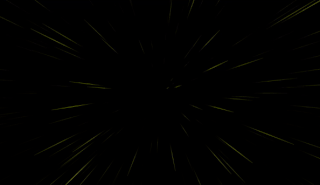
In science fiction, hyperspace is a concept relating to higher dimensions as well as parallel universes and a faster-than-light (FTL) method of interstellar travel. In its original meaning, the term "hyperspace" was simply a synonym for higher-dimensional space. This usage was most common in 19th-century textbooks and is still occasionally found in academic and popular science texts, for example, Hyperspace (1994). Its science fiction usage originated in the magazine Amazing Stories Quarterly in 1931 and within several decades it became one of the most popular tropes of science fiction, popularized by its use in the works of authors such as Isaac Asimov and E. C. Tubb, and media franchises such as Star Wars.
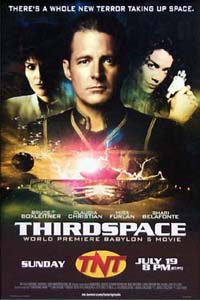
Babylon 5: Thirdspace is a 1998 American made-for-television film that is part of the Babylon 5 science fiction universe. It was written by J. Michael Straczynski and directed by Jesús Salvador Treviño.

Inconstant Moon is a science fiction short story collection by American author Larry Niven that was published in 1973. "Inconstant Moon" is also a 1971 short story that is included in the collection. The title refers to "O, swear not by the moon, th' inconstant moon", a quote from the balcony scene in William Shakespeare's Romeo and Juliet. The collection was assembled from the US collections The Shape of Space and All the Myriad Ways.
Young Jedi Knights is a Star Wars young adult fiction series by science fiction writer Kevin J. Anderson and Rebecca Moesta. It was published from 1995 to 1998. It covers the Jedi training of Jacen and Jaina Solo, the twin children of Han Solo and Leia Organa Solo. The series begins 23 years ABY, when the twins are fourteen years old.
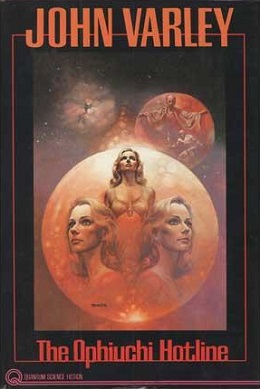
The Ophiuchi Hotline is a 1977 science fiction novel by American writer John Varley. It was nominated for a Locus Award. Part of his Eight Worlds series, the novel opens in the year 2618.

World of Ptavvs is a science fiction novel by American writer Larry Niven, first published in 1966 and set in his Known Space universe. It was Niven's first published novel and is based on a 1965 magazine story of the same name.
"At the Core" is an English language science fiction short story by American writer Larry Niven, published in 1966. It is the second in the series of Known Space stories featuring crashlander Beowulf Shaeffer. The short story was originally published in Worlds of If, November 1966, and reprinted in Neutron Star (1968) and Crashlander (1994).

Line of Delirium and Emperors of Illusions are two 1995 books of a space opera trilogy by Russian science fiction writer Sergey Lukyanenko. The story is told in third person, usually from the viewpoint of Kay Dutch — a professional bodyguard living in a post-war galaxy. The names of races, planets, and several leaders are borrowed from the computer game Master of Orion, although everything else in the trilogy is original, even the physical descriptions of several races.

The Glory That Was is a science fiction novel by American writer L. Sprague de Camp. It was first published in the science fiction magazine Startling Stories for April, 1952, and subsequently published in book form in hardcover by Avalon Books in 1960 and in paperback by Paperback Library in March 1971. It has since been reprinted in paperback by Ace Books in July 1979 and Baen Books in April 1992, and in trade paperback by Phoenix Pick in September 2014. An E-book edition was published by Gollancz's SF Gateway imprint on September 29, 2011 as part of a general release of de Camp's works in electronic form; a second e-book edition was issued by Phoenix Pick in September 2014. The book has also been translated into Italian, German and Greek.

National Lampoon's Men in White is a 1998 American science fiction comedy film parodying contemporary science fiction films, mainly Men in Black and Independence Day. It debuted on the Fox Family Channel.
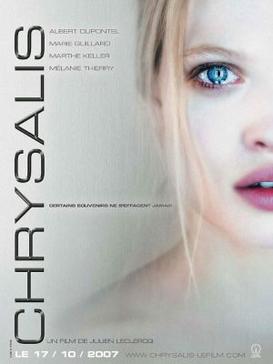
Chrysalis is a French science fiction film directed and co-written by Julien Leclercq and starring Albert Dupontel. The film was commercially released in France on 31 October 2007.

The serialized Mighty Mouse story "The Great Space Chase" from The New Adventures of Mighty Mouse and Heckle & Jeckle seen on the popular Saturday morning series was re-edited into a 1982 superhero comedy film by Filmation.
"Mordru the Merciless" is a story arc that was published by DC Comics, and was presented in Adventure Comics #369-370. It was written by Jim Shooter, pencilled by Curt Swan and inked by Jack Abel. The story arc features the first appearance of Mordru, arguably the most powerful enemy of the Legion of Super-Heroes.
"Star Mort Rickturn of the Jerri" is the tenth and final episode of the fourth season of the Adult Swim animated television series Rick and Morty. Written by Anne Lane and directed by Erica Hayes, the episode was broadcast on May 31, 2020, in the United States. The episode is notable for featuring the first official appearance of "Space Beth", following her creation in "The ABC's of Beth", with the New and Improved Galactic Federation following her back to Earth as she seeks to find out which Beth is a clone.